The History Of Maserati Quattroporte

The Maserati Quattroporte is a luxury four-door sedan made by Maserati of Italy. The name translated from Italian literally means "four doors". There have been five generations of the car, each separated by a period of roughly five years.
In the early 1960s, Maserati's reputation was at a high. With growing sales, Prince Karim Aga Khan ordered a special Maserati 5000 WP, chassis no. 103,060, designed by Pietro Frua. The following year, Maserati showed the first-generation Quattroporte of 1963, which bore a striking resemblance to the earlier drawing.
Also designed by Frua, the 1963 'Tipo 107' Quattroporte joined two other notable grand tourers, the Facel Vega and the Lagonda Rapide, which could comfortably do 200km/ h (124mph) on the new motorways of Europe. However, the Quattroporte could be said to have been the first car specifically designed for this purpose.
It was equipped with a 4.1L (4136cc/ 252in³) V8 engine, producing 256hp (SAE) (191kW) at 5,600rpm, and either a five-speed ZF manual transmission or a three-speed automatic. Maserati claimed a top speed of 230km/ h (143mph).
Between 1963 and 1966, 230 examples were made.
In 1966, Maserati revised the Tipo 107, adding twin headlights (already on the US model) and, from 1968, a 4.7 L, 295hp (SAE) (220kW) engine. Around 500 of the second series were made. Production stopped in 1969.
In 1971, Karim Aga Khan ordered another special on the Maserati Indy platform, given the reference code AM 121.
In 1974, at the Turin Show, Maserati presented its Quattroporte II (AM 123) on a Citroën SM chassis, since Citroën had purchased the Italian company. It had an angular Bertone body, penned by Marcello Gandini and fashionable at the time, and was the only Maserati Quattroporte with a hydropneumatic suspension and front wheel drive, also had the swivelling directional headlights à la DS. However, the 1973 oil crisis had intervened and demand for such cars slowed. Furthermore, the modest V6 powerplant from the mid-engined Merak and the Citroën SM (offering less than 200 horsepower) didn't attract many customers. Maserati made 13 Quattroporte IIs. Six of them originally were pre-production cars and the other seven were built to order between 1975 and 1978.
Considered a "business man's Maserati," the Quattroporte III was launched by newly empowered Maserati chief Alejandro de Tomaso and his design staff in 1976. This was a rear wheel drive car, powered by a large V8 engine. It was important to de Tomaso that there was an Italian vehicle to compete with the recently launched Mercedes-Benz 450SEL 6.9.
The production figures for the Quattroporte are as follows:
- There were 1876 Quattroporte III's produced between 1979 and 1988.
- There were 1821 standard 4portes manufactured between 1979 and 1984.
- The remaining 55 cars were all Royales and were manufactured between late 1984 and 1988. These were the US$80,000 cars that were built to order only.
The Quattroporte III marked the last of the hand-built Italian cars for specialized markets. All exterior joints and seams were filled to give a seamless appearance.
In 1976, Giorgetto Giugiaro presented two ItalDesign show cars on Maserati platforms, called the Medici I and Medici II. The latter in particular featured hallmarks which would make it into the production of the third-generation Quattroporte. By the end of 1976, Maserati announced the Quattroporte III (Tipo AM 330), which took much from the Medici show cars, based on Maserati's Kyalami coupé, which in turn was based on the De Tomaso Longchamp. Special styling emphasis was placed on linearity, which was also useful to tooling cost reduction.
In 1976 the Quattroporte III was launched as "4porte" with a 4.2L engine producing 251hp (SAE) (187kW), later 238hp (SAE) (177kW). Also available was a 4.9 liter V8 (280bhp @ 5800rpm). One distinguishing characteristic of the vehicle was its lavish interior. The car was designed by Giorgetto Giugiaro of coachbuilder ItalDesign. In 1979 the Quattroporte got its true name back and was built with the 4.2L and a new 4.9L engine 278hp (SAE) (207kW). The latter initially had a three-speed Borg–Warner automatic transmission, soon replaced by a Chrysler Torqueflite gearbox. The smaller engine was phased out in 1981.
In 1986, the Maserati Royale, an ultra-luxury version of the Quattroporte III, appeared. The engine was upgraded to 295hp (SAE) (220kW).
In all, 2,141 Quattroporte IIIs were produced, one of them for Italian presidential use. Production ceased in 1990.
See also: Maserati Biturbo
The 4-door Biturbos such as the original 425 weren't aimed at the same customers as the big Quattroporte I, II and III.
All 4-door Biturbos carry the figure "4" in their model name and are based on the 2-door Biturbos with an extended wheelbase. They were available in various "tastes": 11 different models each equipped with a different version of the V6 Biturbo engine (2.0L, 2.5L and 2.8L). Besides being fairly successful as a general model some versions are extremely rare, e.g. the 4.18v was built 77 times and sold solely in Italy. The 4-door Biturbos were the only sedans available from Maserati between 1990 and 1994 and in several markets even between 1986 and 1994 (where the Royale wasn't sold due to emission problems).
The 430 4v was the last version of the 4-door Biturbos. The some technical elements and design were used for the Quattroporte IV.
At the height of Fiat's styling prowess, Maserati was confident to be more adventurous with Quattroporte IV from 1994. Designed by Marcello Gandini, who had penned the Lamborghini Countach, the new car was smaller, very aerodynamic (0.31 cd), and featured Gandini's trademark angular rear wheel arch.
A 2.8L Biturbo V6 was installed, producing 284hp (SAE) (208kW), reaching a top speed of 255km/ h (158mph) while the Italians even had a 2.0L Biturbo V6 producing 287hp (SAE) (211kW) on their price list, both coming from the Maserati Biturbo engine catalog. A V8 3.2L Biturbo was announced in 1995, coming from the Maserati Shamal, developing 330hp (SAE) (246kW) and reaching 263km/ h (163mph).
When Ferrari took over Maserati, it introduced a Quattroporte Evoluzione in 1998. It featured 400 different improvements to Maserati standards of manufacturing. This improved model saw the famous oval Maserati clock disappear from the interior. Production stopped in 2000.
In 2004, Maserati started production of the Pininfarina-designed Quattroporte, with the same dry sump 4.2L engine as the Coupé, Spyder and the new GranTurismo but improved to 400hp (SAE) (298kW). Due to its greater weight than the Coupé and Spyder, the 0-62mph (0-100km/ h) time for the Quattroporte is 5.6 seconds and the top speed is 167mph (269km/ h). The Quattroporte was unveiled to the world at the Frankfurt Motor Show on September 9, 2003 and made its US première at the 2003 Pebble Beach Concours d'Élégance. It is a continuation of the long tradition of Quattroporte luxury sedans in the Maserati line-up.
The 47% front / 53% rear weight distribution (with the DuoSelect transmission) allows the large sedan to have very nimble handling. This weight distribution is achieved by setting the engine further back in the chassis behind the front axle to shift the load back towards the cabin, and the adoption of the Transaxle layout which sees the gearbox rear-mounted in unit with the differential. The transaxle architecture is normally reserved for high performance sports cars and is the first time applied to a luxury sedan. The Quattroporte's weight distribution maximizes traction and thrust during acceleration so that the car remains exceptionally stable and well balanced at all times. With the newer automatic transmission, the transmission is adjacent to the engine and weight distribution changes to 49% front / 51% rear.
Trim levels
The Maserati Quattroporte is offered in four configurations: the base Quattroporte, the Quattroporte Sport GT, the Quattroporte Sport GTS, and the Quattroporte Executive GT.
Sport GT
The Sport GT version of the Quattroporte was introduced at the Frankfurt Motor Show in September 2005. It features a reworked transmission, exhaust, 20 inch wheels, suspension modifications, and special interior and exterior accents including a mesh grille.
Sport GTS
The Sport GTS version of the Quattroporte was introduced at the Frankfurt Motor Show in September 2007. It features a revised suspension, 20 inch wheels, and larger rear tires for improved handling. The brakes received iron/ aluminum rotors for greater fade resistance. Various interior upgrades include alcantara and carbon fiber accents.
Executive GT
The Executive GT version of the Quattroporte was introduced at the North American International Auto Show in January 2006. It is based on a special Neiman-Marcus version, with 19-inch (480mm) ball-polished wheels and an Alcantara suede interior roof lining. Other features include chrome side and front grills and a wood-trimmed steering wheel. Included standard 4WD GT version is a Maserati comfort pack with ventilated, heating, massaging rear seats, retractable wood rear tables, and curtain shades on the rear windows.
Transmissions
Duo Select
The Duo Select transmission was available at the launch of the fifth generation Quattroporte, in 2004. Duo Select was an advancement of the CambioCorsa unit first used in the Maserati Coupe. It is a Ferrari based semi-automatic transmission, located at the rear of the car.
Automatica
Because of reliability problems and rough shifting with the Ferrari based semi-automatic transmission,[citation needed] a full automatic transmission with 6 speeds (by ZF) was presented at the Detroit Motor Show in January 2007 with the first cars delivered right after the launch, marketed as the Maserati Quattroporte Automatica. The Automatica was made available with paddle-shifters on the Sport GT model as standard, but on the base model and the Executive trim levels paddles became an optional extra. With the Automatica, Maserati completely redesigned the under pinning of the car to fit the new conventional automatic transmission and torque converter right behind the engine. They also converted to a wet sump oiling system for cost saving purpose. For the same reasons, the wet sump method is also featured on the up-and-coming Maserati GranTurismo.
Competitors
Only 5,700 Quattroportes were made in 2006. In 2009, the Aston Martin Rapide will be the Quattroporte's main rival as the market, trim, and exclusivity will be very similar, although it will be powered with a V12 engine and will be much more expensive. Also in 2008/ 2009 the Porsche Panamera will be on sale, creating more competition to the high-end luxury saloon segment.
2009 facelift
Images of the 2009 facelifted Quattroporte appeared on the Internet on the 30th of January 2008. The car made its official début at the 2008 Geneva Motor Show. Also making the debut was the Quattroporte S, featuring the same 4.7L V8 as the Maserati GranTurismo S. It has 317kW (431PS; 425hp) of power and 490N·m (361lb·ft) of torque. It is expected to go on sale at the end of 2008. A Quattroporte Sport GT S is also offered with 323kW (439PS; 433hp) of power.
From Wikipedia, the free encyclopedia
More About Maserati Quattroporte
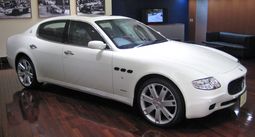

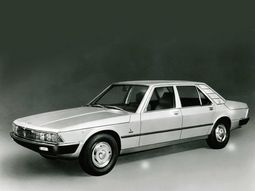
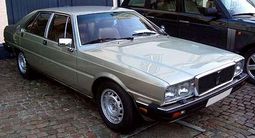
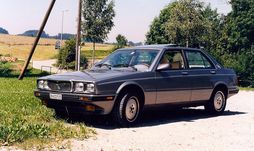
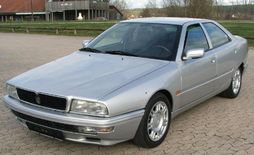
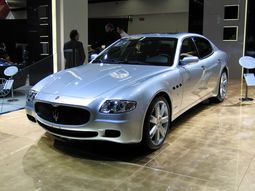
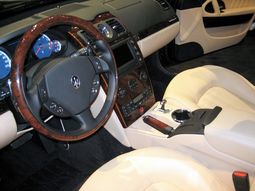
|